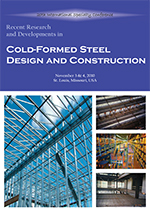Session Dates
03 Nov 2010
Abstract
Light weight Steel Framed structures currently in use in Australia, are normally braced using face mounted thin straps, cross braces that are of the same shape as studs, or compressed cement boards screwed to the face of the walls. While these are found adequate in low seismic regions of Australia, an investigation into the earthquake resistance properties of LSF have led authors to investigate alternative bracing types that may present a more favourable ductility. Knee braces that are specially designed for this purpose are introduced in the paper and studied in a specially designed testing rig. The tests are on four full scale walls of 2.4 m × 2.4 m and are of a cyclic nature. Of particular interest are the specimens maximum lateral load capacity and the load-deformation behaviour. The study also looks at the failure modes of the system and investigates the main factors contributing to the ductile response of the LSF walls in order to suggest improvements so that the shear steel walls respond plastically with a significant drift and without any risk of brittle failure such as connection failure or stud buckling. The walls tested have different length of Knee-elements with or without brackets which have same length of Knee-elements. The study shows that although the performance of this kind of LSF lateral resistant system under cyclic loads is satisfactory, its shear strength is significantly lower than those LSF lateral resistant systems which are currently in use in Australia. In regions with medium to high seismic activity, the use of these braces would not be sufficient purely as to the lateral resistance.
Department(s)
Civil, Architectural and Environmental Engineering
Research Center/Lab(s)
Wei-Wen Yu Center for Cold-Formed Steel Structures
Meeting Name
20th International Specialty Conference on Cold-Formed Steel Structures
Publisher
Missouri University of Science and Technology
Document Version
Final Version
Rights
© 2010 Missouri University of Science and Technology, All rights reserved.
Document Type
Article - Conference proceedings
File Type
text
Language
English
Recommended Citation
Dastjerdi, Mehran Zeynalian and Ronagh, Hamid Reza, "Performance of Knee-braced Cold-formed Steel Shear Walls Subjected to Lateral Cyclic Loading" (2010). CCFSS Proceedings of International Specialty Conference on Cold-Formed Steel Structures (1971 - 2018). 3.
https://scholarsmine.mst.edu/isccss/20iccfss/20iccfss-session9/3
Performance of Knee-braced Cold-formed Steel Shear Walls Subjected to Lateral Cyclic Loading
Light weight Steel Framed structures currently in use in Australia, are normally braced using face mounted thin straps, cross braces that are of the same shape as studs, or compressed cement boards screwed to the face of the walls. While these are found adequate in low seismic regions of Australia, an investigation into the earthquake resistance properties of LSF have led authors to investigate alternative bracing types that may present a more favourable ductility. Knee braces that are specially designed for this purpose are introduced in the paper and studied in a specially designed testing rig. The tests are on four full scale walls of 2.4 m × 2.4 m and are of a cyclic nature. Of particular interest are the specimens maximum lateral load capacity and the load-deformation behaviour. The study also looks at the failure modes of the system and investigates the main factors contributing to the ductile response of the LSF walls in order to suggest improvements so that the shear steel walls respond plastically with a significant drift and without any risk of brittle failure such as connection failure or stud buckling. The walls tested have different length of Knee-elements with or without brackets which have same length of Knee-elements. The study shows that although the performance of this kind of LSF lateral resistant system under cyclic loads is satisfactory, its shear strength is significantly lower than those LSF lateral resistant systems which are currently in use in Australia. In regions with medium to high seismic activity, the use of these braces would not be sufficient purely as to the lateral resistance.



